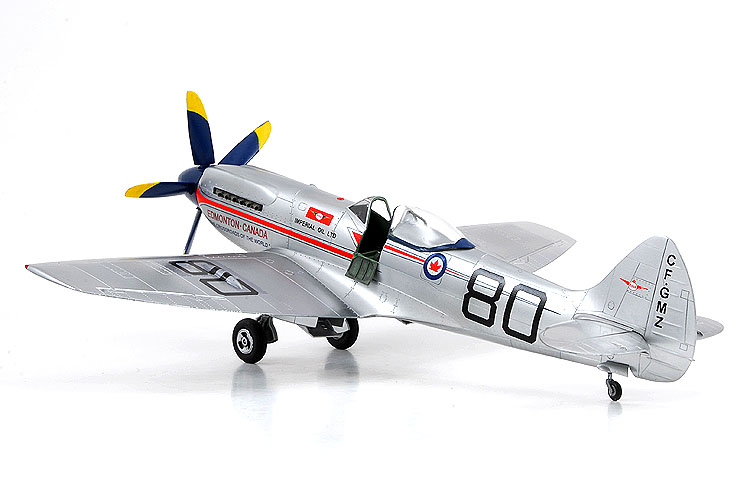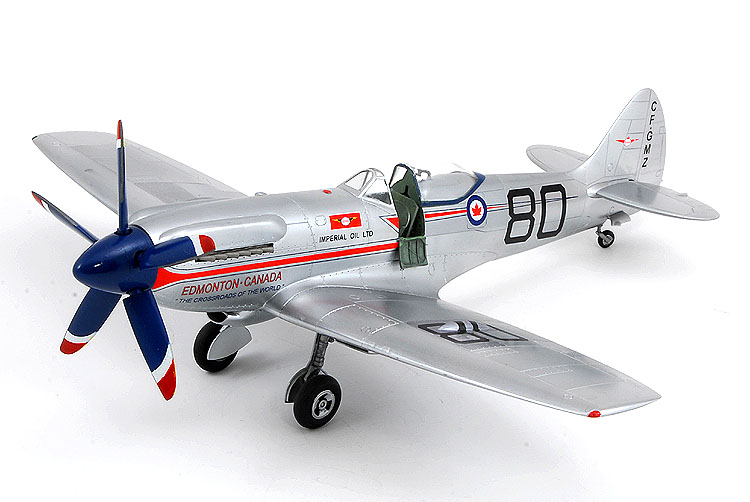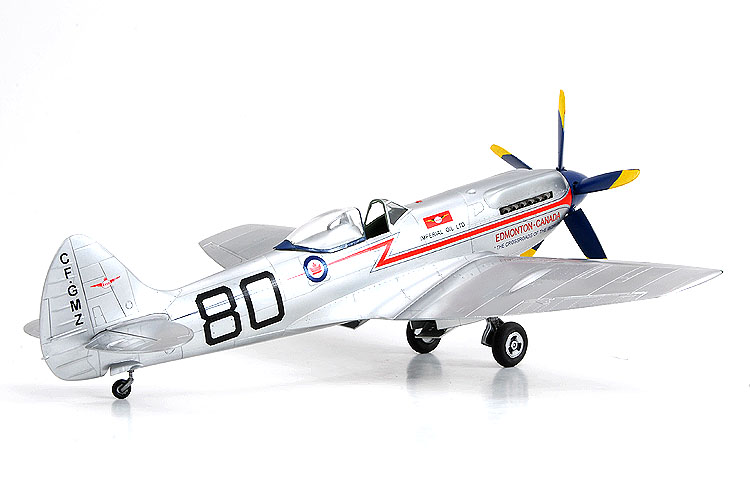

Although it seems I've built more than my share of Spitfires, I'm actually indifferent to the type. But there is no way I could pass this Spitfire by, with its Canadian heritage, civilian paint scheme and fantastic story.
Kit:
Aftermarket:
Date:
Academy (2161)
Wheels from a late-mark Airfix Spitfire and Belcher Bit decals (Special Decals 1)
2008
The Edmonton Air Racer - A modelling project 12 years in the making
This is one of those models where the story of how it came to be plays the greatest part in the model’s construction. It’s not a fantastic model, nor is it one of my best builds,
but for me it’s the story behind the model that has made it one of my favourites.
Back when I was in high school I came across a black and white photo of a Supermarine Spitfire, Mk.XIVe in an old magazine. Unlike all the other Spitfires I’d seen this one was
a) all natural aluminium, b) civilian, and c) flown as an air racer by some people in Edmonton. Right then and there I knew I had to build this airplane.
About this time Academy released two 1/48th scale kits of the Mk. XIV, a razorback and a bubble top. I snapped one up and began building my air racer. This was before the days of
ALPs printers and custom printed decal sheets, so I simply planned on painting the stripes and logos myself. A short while later I discovered that Mike Belcher of Belcher Bits
had done a set of decals for this plane. I quickly sent a cheque and forgot all about hand painting those logos. But there’s a saying, “one step forward, one step back” and I
royally screwed up the primer coat. My Spitfire took its maiden flight into the garbage can.
Years passed and other projects came and went, but I still kept that decal sheet. Eventually I picked up another Academy kit. Again, it sat on the shelf while other projects came
and went. Then it finally happened.
After years of asking, my bosses finally agreed to send me to Seattle for a week of training – hurray. Unfortunately they wouldn’t pay for a rental car and the less than savoury
part of town I was staying in had very little in the way of after-hours entertainment. I decided to take advantage of my captive situation and took along a model to build.
As I looked through my stash I knew that whatever model I chose, I needed it to be rugged enough to withstand the flight home in the baggage compartment of a commercial airliner.
That meant nothing delicate, nothing that needed lead weights (no nose wheels), but also something complicated enough to keep me occupied for a couple nights. I settled on a
Czech Models Beech T-34C Turbo Mentor and my extremely patient Academy Spitfire.
Academy moulded this model in a medium grey styrene with fine recessed panel lines. The only option for additional detailing came in the opening cannon bays – which remain closed
for obvious reasons.
Because I didn’t want to risk travelling with paints, I painted the cockpits before I left home, bringing only some liquid glue and super glue, Mr. Surfacer liquid putty, a knife
and an assortment of sanding sticks.
Over the course of four nights I assembled my models and had them ready for paint. Once I came back to Calgary all that remained was to glue the landing gear in place, mask the
canopies and start painting.
This was the first time I’d tried using Alclad paints and a lot of scratches showed up with the first coat. But taking some advice from my brother, we sprayed the whole model
with Future floor wax. The Future sealed the scratches, created a smooth surface and allowed the next coat of Alclad to hide everything. Even though they were more than a decade
old the decals worked perfectly, and thanks to a local club member, I was even able to match the late style wheel rims the original used.
One down side to this model was that after all those years my project had spent in hibernation, the flood gates appear to have opened on Edmonton air racing Spitfires. At the
local model contest, after years of never seeing an air racer, someone placed a 1/72nd scale version right beside mine. Academy has also reissued their kit and included decals
for this same plane.
The worst part was that I later discovered that Ken Brown, a pilot famous for his participation in the famous Dam Busters raid, was the owner of this plane. I wish I’d known that
a couple years ago when he spoke during a local RCAF mess dinner. It would have been an interesting story to hear.

There are two minor mistakes I wish I had known about before building this model. There should be no bulges on the cannon doors, and the forward windscreen framing was painted blue too.
